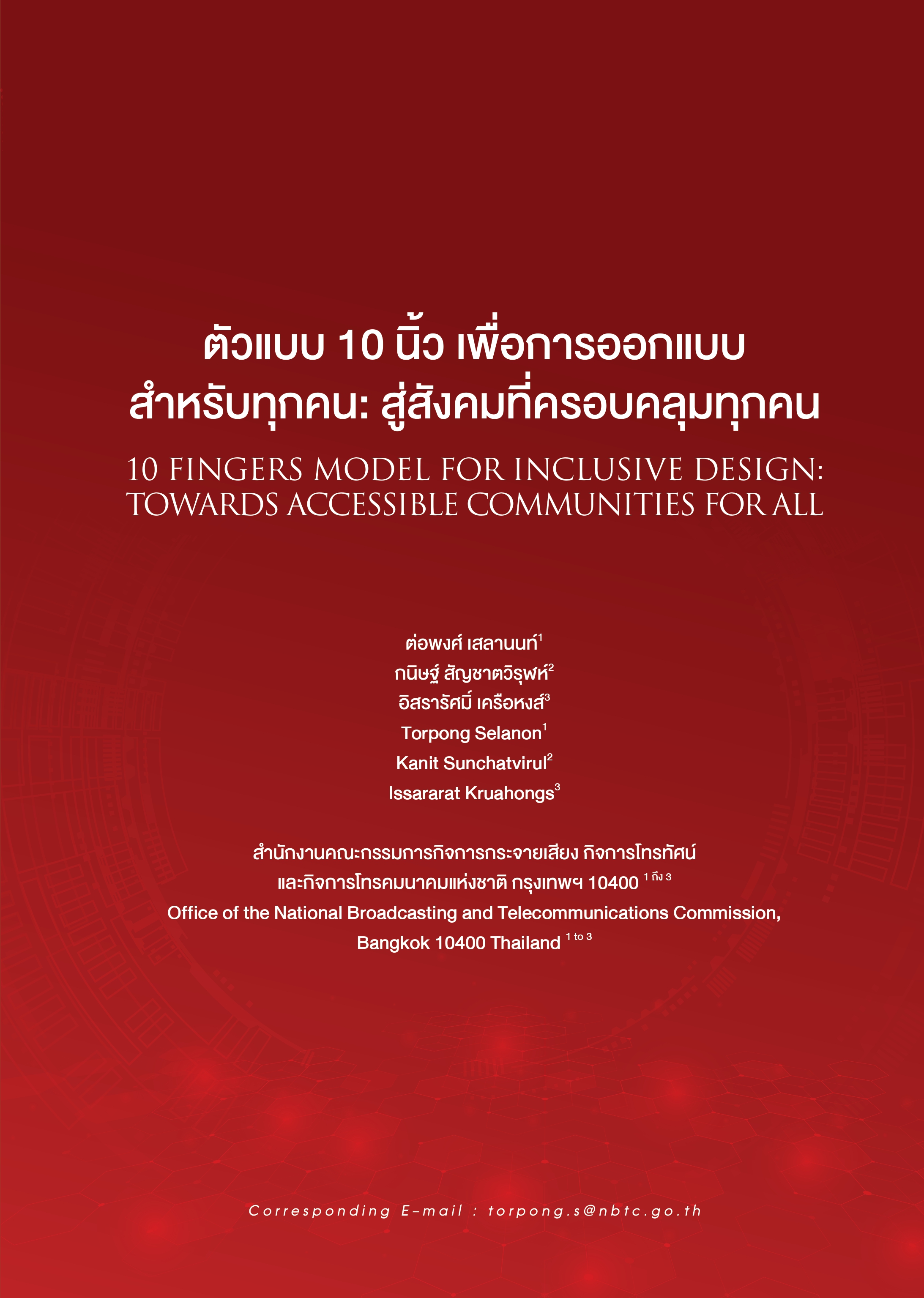10 Fingers Model for Inclusive Design: Towards Accessible Communities for All
Keywords:
inclusive design, 10 Fingers Model, equity, accessibility, Thai societyAbstract
Inclusive design is a crucial concept for creating an equitable and accessible society for all. This article presents the “10 Fingers Model” for inclusive design. The model uses the 10 fingers as symbols representing key components to consider in the design process. The model comprises 5 physical environment components and 5 human-centered technology components. 5 physical environment components include urban design, landscape design, architectural design, interior design, and product design, components; and five human-centered technology components consist of users, skills, smart devices, software applications, and connectivity. This study was based on a review of relevant literature published between 2000 and 2023. The findings revealed that inclusive design positively impacts quality of life, economy, social participation, innovation, and the environment. It enhances the lives of the elderly and disabled, creates new business opportunities, promotes social inclusion, stimulates innovation, and supports sustainable development. However, implementing this concept in Thailand still faces challenges. Recommendations include raising awareness, developing personnel skills, improving policies and laws, and promoting collaboration among various sectors to create an inclusive society for all in Thai society.
References
กฎกระทรวงกำหนดหลักเกณฑ์ วิธีการ และเงื่อนไขในการเข้าถึงและใช้ประโยชน์จากข้อมูลข่าวสาร การสื่อสารบริการโทรคมนาคม เทคโนโลยีสารสนเทศและการสื่อสาร เทคโนโลยีสิ่งอำนวยความสะดวกเพื่อการสื่อสาร และบริการสื่อสาธารณะ สำหรับคนพิการ พ.ศ. 2554. (2554). ราชกิจจานุเบกษา. เล่ม 128 ตอนที่ 38 ก. หน้า 9-13. https://dl.parliament.go.th/backoffice/viewer2300/web/previewer.php
พระราชบัญญัติส่งเสริมและพัฒนาคุณภาพชีวิตคนพิการ พ.ศ. 2550. (2550). ราชกิจจานุเบกษา. เล่ม 124 ตอนที่ 61 ก. หน้า 8-14. https://dl.parliament.go.th/backoffice/viewer2300/web/previewer.php
สำนักงานคณะกรรมการดิจิทัลเพื่อเศรษฐกิจและสังคมแห่งชาติ (สดช.). (2561). แผนพัฒนาดิจิทัลเพื่อเศรษฐกิจและสังคม. https://onde.go.th/view/1/Digital_Development_for_National_Economic_and_Social_Development/EN-US
สุทธิดา อุ่นจิต. (2562). Universal Design. The Cloud. https://readthecloud.co/universal-design/
Accenture. (2018). Getting to Equal: The Disability Inclusion Advantage. https://www.accenture.com/content/dam/accenture/final/a-com-migration/pdf/pdf-89/accenture-disability-inclusion-research-report.pdf
Apple. (2023). Accessibility. https://www.apple.com/accessibility/
Bayor, A. A., Sitbon, L., Ploderer, B., Bircanin, F., Koplick, S., & Brereton, M. (2019). Leveraging participation: Supporting skills development of young adults with intellectual disability using social media. In Proceedings of the 21st International ACM SIGACCESS Conference on Computers and Accessibility. ASSETS '19 (pp. 143-155). NY: ACM. https://doi.org/10.1145/3308561.3353793
Bertot, J. C., Estevez, E., & Janowski, T. (2016). Universal and contextualized public services: Digital public service innovation framework. Government Information Quarterly, 33(2), 211-222. https://doi.org/10.1016/j.giq.2016.05.004
Carnemolla, P., & Bridge, C. (2019). Housing design and community care: How home modifications reduce care needs of older people and people with disability. International Journal of Environmental Research and Public Health, 16(11), 1951. https://doi.org/10.3390/ijerph16111951
Clarkson, J., Keates, S., Coleman, R., & Lebbon, C. (Eds.). (2003). Inclusive Design: Design for the Whole Population. Springer London. https://doi.org/10.1007/978-1-4471-0001-0
Cooper, T. (2010). Longer lasting products: alternatives to the throwaway society. Gower.
Erlandson, R. F. (2007). Universal and accessible design for products, services, and processes. CRC Press.
European Commission. (2023). Digital Public Services in Europe. https://ec.europa.eu/digital-strategy/digital-public-services_en
Google. (2023). Accessibility - Google. https://www.google.com/accessibility/
i-CREATe. (2024). Intelligent Technology Empowers the Future of Rehabilitation. http://www.i-create-wrrc.com/International
Telecommunication Union (ITU). (2024). DIGITAL SKILLS FORUM INTERVIEWS: Torpong Selanon, Commissioners, NBTC, Thailand [Video]. Youtube. https://youtu.be/YRecOwMxXDE?si=u96mHDnu9oVwD67x
LePage, P. & Andrew, R. (2019). Responsive Web Design Basics. Google Developers. https://developers.google.com/web/fundamentals/design-and-ux/responsive
Mackelprang, R. W., & Salsgiver, R. O. (2016). Disability: A Diversity Model Approach in Human Service Practice. Oxford University Press.
Microsoft. (2016). Inclusive Design Toolkit. https://www.microsoft.com/design/inclusive/
Microsoft. (2023). Accessibility - Microsoft. https://www.microsoft.com/en-us/accessibility
NEC. (2024). Universal Design. https://www.nec.com/en/global/design/ud/index.html
Persson, H., Åhman, H., Yngling, A. A., & Gulliksen, J. (2015). Universal design, inclusive design, accessible design, design for all: different concepts—one goal? On the concept of accessibility—historical, methodological and philosophical aspects. Universal Access in the Information Society, 14, 505-526. https://doi.org/10.1007/s10209-014-0358-z
Pullin, G. (2009). Design Meets Disability. The MIT Press.
Rossi, M., Germani, M., & Zamagni, A. (2016). Review of ecodesign methods and tools. Barriers and strategies for an effective implementation in industrial companies. Journal of Cleaner Production, 129, 361-373. https://doi.org/10.1016/j.jclepro.2016.04.051
Steinfeld, E., & Maisel, J. (2012). Universal design: Creating inclusive environments. John Wiley & Sons.
United Nations (UN). (2015). Transforming our world: The 2030 agenda for sustainable development. New York: United Nations. https://sdgs.un.org/2030agenda
W3C Web Accessibility Initiative. (2020). WCAG 2 Overview. https://www.w3.org/WAI/standards-guidelines/wcag/
Welch, P., & Jones, S. (2001). Advances in universal design education in the United States. In W. F. E. Preiser & E. Ostroff (Eds.), Universal design handbook (pp. 51.1-51.24). New York: McGraw-Hill.
World Bank. (2020). Community-driven city planning with the Yokohama Citysketch Workshop. https://www.worldbank.org/en/news/feature/2020/02/02/community-driven-city-planning-with-the-yokohama-citysketch-workshop
World Economic Forum. (2020). The Future of Jobs Report 2020. Geneva: World Economic Forum. https://www.weforum.org/publications/the-future-of-jobs-report-2020/
Zoom. (2023). Accessibility Features. https://explore.zoom.us/en/accessibility/

Downloads
Published
How to Cite
Issue
Section
License
Copyright (c) 2024 Journal of Digital Communications

This work is licensed under a Creative Commons Attribution-NonCommercial-NoDerivatives 4.0 International License.
The Office of the NBTC holds the copyright of articles appearing in the journal. The Office of the NBTC allows the public or individuals to distribute, copy, or republish the work under a Creative Commons license (CC), with attribution (BY), No Derivatives (ND) and NonCommercial (NC); unless written permission is received from the Office of the NBTC.
Text, tables, and figures that appear in articles accepted for publication in this journal are personal opinion and responsibility of the author, and not binding on the NBTC and the Office of the NBTC. In case of errors, each author is solely responsible for their own article, and not concerning the NBTC and the NBTC Office in any way.


